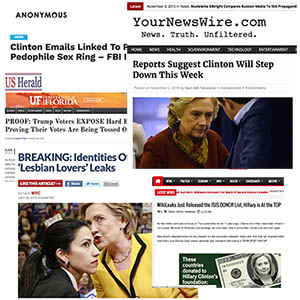|
|
“Trump Voters Expose Hard Evidence Proving Their Votes Are Being Tossed Out.”
“WikiLeaks Just Released the ISIS Donor List, Hillary is at the Top.”
“Reports Suggest Clinton Will Step Down This Week.”
“Identity of Hillary’s Secret ‘Lesbian Lover’ Leaks.”
These are just several of the hyperbolic headlines I’ve stumbled across in the last week, each belonging to one of the many fake news outlets that have gained massive popularity online. An outbreak of clickbait and share-bait sites, hoax stories, conspiracy resources and partisan propaganda outfits whose reportage reads like a political campaign’s house organ has exploded on the web in recent years, deceiving readers and fomenting mass paranoia in the process.
These sites would’ve been delegated novelties a decade ago, basement blogs achieving perhaps a few hundred hits a month, but thanks to the advent of social media, specious content that’s now widely recirculated throughout the ether like a virus of nonsense has become a cottage industry. In an October 25 New York Times editorial titled “Your Facts or Mine?” contributing writer Emma Roller posited that social media’s circulatory power has lent these bogus outlets an air of credibility, despite the fact that, unlike other media, “they have no responsibility to separate truth from fiction.”
“If share-baiting Facebook posts are the junk food of the political Internet,” Roller wrote, “then fact-check journalism is steamed spinach.”
 |
The paradox is fascinating if you think about it: even though we have access to more information than any other time in human history, we’re collectively becoming less aware. As it turns out, we’d rather live with our own fictions of the world than what’s actually happening; we’ll gravitate not toward content that challenges our worldviews but content that confirm them. The information we’re most likely to share is increasingly becoming information that’s least likely to inform. We can have not just our own opinions, but also our own truths. We live in a post-fact era, where the content that gets the most eyeballs wins. If a lie is repeated enough times, well, it must be true.
The rise of fact-challenged news is alarming in its own right. But consider that we’re also engaged in one of the most divisive, populist-themed presidential elections in history, with a beleaguered electorate that harbors a long-standing distrust of mainstream media, and we might understand that a proliferation of feral outlets that exploit readers’ rage and confirm their delusions of persecution in exchange for some profitable clicks can actually make for a dangerous environment as well.
In an October segment dedicated to the growing fake news phenomenon, CNN’s senior media correspondent Brian Stelter said these outlets can be separated into three categories: deliberate hoaxes; hyper-partisan sites intended to mislead audiences; and stories that take one true claim and stir in a lot of falsehood. Admittedly, some of the disinformation out there is more innocent than others. Several months ago, thousands of Facebook users were gullible enough to recirculate a photo purporting to document the Standing Rock protests taking place in North Dakota, even though it was actually a photo taken at the Woodstock music festival in 1969. Other times, the deception borders on hilarious: News Corp owned site Heat Street in early October inadvertently paid homage to late fictional tabloid the Weekly World News in its reportage on Hurricane Matthew, when it claimed that storm “is heading straight for Mar-a-Lago, and President Obama isn’t doing anything to stop it.”
This isn’t a phenomenon limited to the political right. OccupyDemocrats on October 29 ran a headline titled “FBI Director Just Admitted His New Hillary Probe Is a Smear to Help Trump.” The same day, liberal site PoliticusUSA offered an article titled “The Religious Right Warns Witchcraft Could Decide This Election.”
To combat the spread of these fringe sites, Stelter recommends viewers “triple check” information before sharing it with others. It’s sound advice, and a practice whose application could start among mainstream outlets. Fox News host Sean Hannity on November 1 apologized for circulating a false report from right wing political blog The Gateway Pundit that claimed Michelle Obama had deleted Clinton-related tweets from her Twitter timeline. By the time Hannity’s bunk announcement was recirculated among the social networks, our virtual game of telephone morphed that report into claims that President Obama and Elizabeth Warren had deleted Clinton’s tweets too. Apparently the country’s political leaders have the emotional comportment of irate 12-year-olds.
Facebook in August apologized when its Trending Topics news feature falsely reported that Fox News anchor Megyn Kelly had been fired from the network. Trending Topics, which stirred controversy earlier this year when contractors claimed they’d routinely suppressed conservative news items, was subject to a recent retooling that involved slashing news staff and replacing them with news hunting algorhythms. Facebook’s newfangled automation apparently didn’t sniff out the dubious claims made in the linked Kelly article, however, which originally appeared on a partisan site titled End The Fed and reported that Kelly had been terminated for being “a closet liberal who actually wants Hillary to win.”
What's perhaps most troubling, however, is when an otherwise legitimate news service appropriates behavior that's now been normalized by these spurious sites. Popular culture and current affairs mainstay Slate on October 31 released a bombshell 4,000-word report detailing how computer scientists had discovered that a server allegedly registered to the Trump Organization was engaging in regular communication with a server belonging to Alfa Bank, the largest private commercial bank in Russia. As it turns out, lobbyist Richard Burt, who has advised Trump, sits on Alfa Bank’s senior advisory board. Moreover, Alfa president Pyotr Aven allegedly has tenuous ties to Vladimir Putin going back to when the Russian president held government positions in Saint Petersburg.
Tracking the servers’ communications patterns, computer scientists claimed activity appeared to correspond with election happenings in the U.S. While admitting that what the scientists discovered “wasn’t a smoking gun,” the article concludes that “this evidence arrives in the broader context of the campaign and everything else that has come to light … it deserves further explanation.” In other words, what the Slate article hints at, what it conveniently leaves off the page — but never adequately explains — is resoundingly clear: Trump is covertly colluding with the Russian government.
Though the article’s implied conclusion is bolstered entirely by conjecture, the faux-news outlets of the web ran with Slate's story anyway, and within hours, social media was rife with headlines armed with a grossly unearned narrative: Trump is now involved in a server scandal of his own. This, of course, stoked only more mass paranoia, and fingers on social media have been aflutter ever since with questions regarding why FBI Director James Comey won’t turn his attention from the Clinton email scandal and do something to stop Trump’s obvious Benedict Arnold for Mother Russia.
Embarrassingly, the New York Times issued a report on the same day that directly contradicted Slate’s supposition, revealing the FBI, over the course of a months-long investigation into any role Russia may have had in meddling with the 2016 presidential campaign — including possible communication between the Trump Organization and Alfa Bank — could find no conclusive link so far between Trump and the Russian government.
That’s the difference between reportage and rumor. Unfortunately, the latter is usually far more popular than the former.



 The ridiculously high prices Americans are paying at the supermarket might influence how—or if—they vote in November.
The ridiculously high prices Americans are paying at the supermarket might influence how—or if—they vote in November. At a moment in history when there are so many conflicts among peoples here and abroad, let us put our differences aside and celebrate this wonderful season in a spirit of togetherness.
At a moment in history when there are so many conflicts among peoples here and abroad, let us put our differences aside and celebrate this wonderful season in a spirit of togetherness. The news announcing the death of Henry Kissinger, the last of the prevaricating politicians and so-called statesmen who stole my future and that of thousands of other young Americans, got me thinking about Walter Cronkite.
The news announcing the death of Henry Kissinger, the last of the prevaricating politicians and so-called statesmen who stole my future and that of thousands of other young Americans, got me thinking about Walter Cronkite.


 Have a comment? Send it to
Have a comment? Send it to 
No comments have been submitted for this story yet.